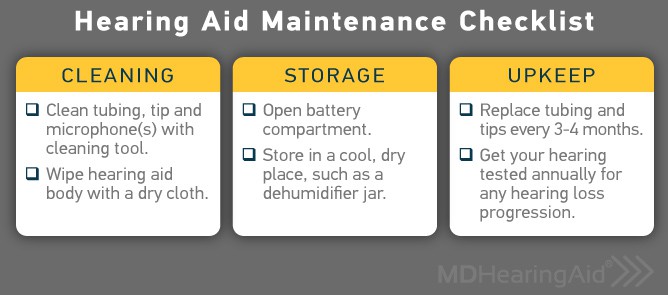Buying hearing aids can seem really complicated. We hope our hearing aid buyer’s guide has helped you figure out the right place to buy it, the right kind of hearing aid for you, and the features you’re looking for in your first hearing aid. This guide was designed to help you feel confident throughout the entire hearing aid experience, and that includes what happens after you place your order. As you’re finalizing your hearing aid purchase, here are things to keep in mind… both right now and throughout your time wearing hearing aids.
Hearing Aid Protection Plans vs. Warranties
Before you buy your hearing aid, make a point to review your options for protection plans as well as the warranty guidelines. This is an expensive piece of technology, and it’s also very small. Make sure your new purchase has a warranty in case of hardware failure. Hearing aids tend to come standard with some kind of warranty plan, but they only cover certain situations. For instance, you might not be covered if your dog eats your hearing aid or you accidentally wear it in the shower.
On the other hand, protection plans are additional coverage you can add on to protect from a wide variety of accidental damage. It’s important to review the details of both the warranty and whatever protection plans are offered by your hearing aid provider. Make sure you know what is covered under each so that you can weigh the cost of the protection vs the risk of buying without that protection.
Hearing Aid Accessories
There are a lot of hearing aid accessories on the market, and some are more useful than others.
Most hearing aids come with a complimentary cleaning tool with a little brush. Keeping your hearing aids clean and well maintained is a big part of keeping the sound from your hearing aids clear, so this little tool is going to be a big help to you. If it breaks or gets lost, the tool is very inexpensive to replace, too. MDHearing is unique in that our cleaning tool comes with two different parts: a long wire for cleaning debris out of the hearing aid tubing and the small brush to cleaning the tips and the microphone.
Like most electronics, excessive moisture can quickly destroy a hearing aid. Consider investing in a hearing aid dehumidifier as overnight storage to remove sweat, hair oils, and other moisture from your hearing aids. The UV Clean and Dry Box uses gentle dry heat and ultraviolet light to sanitize your hearing aids. We also recommend getting some kind of travel storage case for your hearing aids. This will be useful at the hairdresser, at the pool, and any other time you need to pack your hearing aids safely away.
Another accessory you may receive with your hearing aids is a set of different size tubing and tips so you can find the best fit for your ears. MDHearing provides complimentary tubing options and ComfortTIPs, which have a unique curve like an ear canal. If those do not work for you, we can also provide additional sizes and shapes to better suit your needs. No matter what style you choose, tips and tubing get worn down after about 3-4 months and will need to be replaced in order to keep your hearing aids working and sounding like new.
If an even more precise fit is desired or required, any of our hearing aid models can be fitted with a custom ear mold. These can be obtained from an online store or from a local audiologist or hearing aid dispenser.
Putting on Your Hearing Aids for the First Time
It can be a mix of nerve-wracking and exciting to put on your new hearing aids for the first time. Read through and carefully follow the instructions manual provided with your hearing aid. Online hearing aid companies will often have a customer service team available by phone or email if you have questions or need help putting your hearing aids in and getting them working the first day. If you’re buying through a clinic, they should be help you fit the device comfortably into place when you pick them up.
The very first time you put on your new hearing aids, you might notice some sounds—like footsteps or the ticking of your living room clock—seem too loud. This is very common for first time hearing aid users. Your brain doesn’t quite know how to prioritize all of these sounds yet. Building up your hearing skills again is going to take time and consistent practice.
Acclimating to Your Hearing Aids
It takes the human brain at least 3-4 weeks to adjust to new hearing aids. This is where a lot of new hearing aid users get stuck; they assume their early discomfort means the hearing aids don’t work correctly. Instead of sending them back, give your brain the time to process these new sensory experiences. MDHearing has a 21 day minimum trial period because we want you to give your brain a chance to really acclimate to the hearing aids.
Will you need hearing aid adjustments?
If you buy your hearing aids through a hearing clinic or audiologist’s office, you will need to go in for multiple adjustment appointments at the beginning, and then periodical adjustment appointments for the entirety of the life of your hearing aid. This is the traditional process for getting and using a hearing aid, which can be time consuming as well as a further strain on your budget if it’s not covered by your insurance.
MDHearing’s models are designed to address the most common hearing loss situations ranging from mild to moderately severe hearing loss. Because of that, you won’t need countless adjustment appointments. And if you’re looking for more customization, the LifeEar CORE is able to be adjusted in the comfort of your home through Bluetooth technology and our user-friendly mobile app.
Ongoing Maintenance and Cleaning
You should clean your hearing aid every day. Many users find it’s helpful to make it part of their nightly routine as they get ready for bed. Make sure to follow the specific cleaning instructions that come with your hearing aid kit.
For MDHearing users, it’s pretty simple to clean your hearing aid. At the end of every day, use your cleaning tool to brush your hearing aid tip and microphone to get rid of debris. Then carefully thread the cleaning tool wire all the way through the base of the tubing and out the tip end. Wipe the end of the wire clean, pull it back, then wipe the wire down again. Repeat as necessary—you should be able to see when the tubing is completely clean of debris.
Other things to keep in mind:
- Store your hearing aids with their battery compartment open. Any cool, dry place will work, but you can also store them overnight in a hearing aid dehumidifier or UV Clean and Dry Box.
- To avoid battery corrosion, make it a habit to keep the battery compartment open and remove the battery if you are not using your hearing aid for a long period of time.
- Even if your hearing aids are water resistant or waterproof, avoid exposing them to excess moisture.
- If condensation has gotten in your hearing aid, take the battery out and gently wipe it as well as the inside of the compartment. Let the hearing aid fully dry before putting the battery back in the device.
- Excessive heat, like accidentally putting them in the dryer or leaving them out in direct sunlight, can badly damage your hearing aids. Avoid leaving them in a hot car during the summer. It’s also a good idea to take them out if you’re going to use your hair dryer.
Troubleshooting Common Hearing Aid Problems
- If there’s no sound from the hearing aid at all, check the tubing and the microphone/tip for blockage. Then try replacing the battery.
- If you have issues with sound distortion or whistling feedback, first try lowering the volume. If the whistling continues, check that the tips and tubing aren’t dirty, damaged, or misaligned with your ear.
- If sound starts cutting out, there could be dust in the controls. Switch or rotate the controls to dislodge the debris and then reset your preferences. If that doesn’t work, the battery could be getting low and needs replacing.
When should you replace your hearing aid?
Typically, hearing aids will last 5-7 years. Those aren’t set numbers, since proper care and regular maintenance will help you prolong the life of your hearing aid, and improper care will damage it. That’s why it’s so important to keep your hearing aids dry and clean. They’re an expensive medical device and you should be able to get years out of them. But like all technology, no hearing aid lasts forever. Here are a few telltale signs you should be looking for a new pair:
- If your hearing loss has changed significantly (meaning your current hearing aid could be working fine but might not be powerful enough for your current needs).
- If your hearing aids regularly need repairs but have no protection plan or are out of warranty.
- If you’re interested in upgrading to newer technology, like Bluetooth or smartphone controls.
When you do finally need a new hearing aid, it’s a good idea to go back and get your hearing checked at a clinic or an audiologist office. A new hearing test provides clarity on the state of your hearing loss as it is today. But like we said in Chapter One, you don’t have to buy your hearing aids at the clinic. You always have the option to shop around after your test results come in. By taking all the lessons in this buyer’s guide to heart, you can make informed, confident decisions about your hearing health for decades to come.
When you choose from MDHearing’s great selection, you get free shipping, 45 day risk-free trial, and a money-back guarantee.
ORDER YOUR HEARING AIDS


